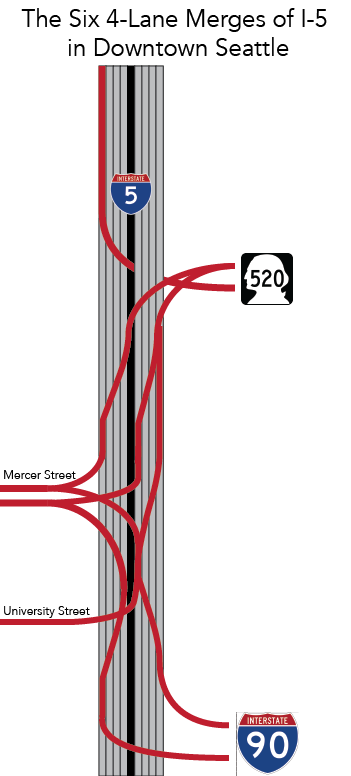How Mercer and 520 Hurt Seattle Traffic

Traffic in Seattle is notoriously terrible, and the most oft-cited causes are strong economic growth and lack of rapid transit. While both of those factors are at play, it's underappreciated just how the details or our freeway construction actively contribute to our daily traffic headaches.
Put aside for a moment the myriad complaints about I-5 in Seattle - that there is zero HOV priority between Northgate and Union Street, that the antiquated and unidirectional express lanes still freely permit SOVs, and that such SOVs are forced to exit in our fastest growing neighborhood (South Lake Union), etc. - there are also basic engineering reasons why our daily bottlenecks occur so predictably.
Consider just the area between NE 45th Street and I-90. In that roughly 4-mile stretch there are six overlapping 4-lane merges, four of which are attributable to Mercer Street alone. They are:
1. NE 45th Street to eastbound SR 520 (4 lanes in 0.8 miles)
Cars headed to the Eastside from NE 45th Street have just the 0.8 miles of the Ship Canal bridge to merge across 4 lanes to access the left-side exit to eastbound 520.
2. Eastbound University Street to eastbound SR 520 (4 lanes in 2 miles)
Cars using the University Street on-ramp are dumped into the left lane of northbound I-5 just as cars are merging left to access the Mercer Street off-ramp. Those headed for SR 520 have a bit longer (2 miles) to cut across all lanes of traffic to access the SR 520 on-ramp.
3. Eastbound Mercer to Eastbound SR 520 (4 lanes in 0.8 miles)
4. Westbound SR 520 to Westbound Mercer (4 lanes in 0.6 miles)
The Mercer-to-520 merges are the tightest in the city, 4 lanes in just 0.6-0.8 miles. Both merges dump you into the left lanes before requiring a quick merge to access right side on ramps.
If you wondered why Metro's proposed Route 311 from Woodinville to South Lake Union would have used the express lanes via 42nd street instead of merging directly to Mercer, this is why. The merge is too short to be done safely by buses, and frankly cars have no business doing it either.
5. Eastbound Mercer to Eastbound I-90
Cars using the Mercer on-ramp to southbound I-5 are dumped into the left lane just as it again becomes an HOV lane for the first time since Northgate, forcing all SOVs to immediately merge. Those headed from Mercer to I-90 have to merge further, needing to cross 4 lanes in 1 mile in to access the collector-distributor lanes where the I-90 ramps are located.
6. Westbound I-90 to Westbound Mercer (7 lanes in 2 miles)
Requiring 7 lanes in 2 miles, this is perhaps the most chaotic of them all. At the I-5 on-ramp from westbound I-90 (near Dearborn), cars merge into the right lane of the 4-lane "collector-distributor" lanes, and they have until Madison Street (1 mile) to merge all the way left to the through lanes. After Madison, the collector-distributor lanes rejoin the mainline in the center-right lane, requiring cars headed for Mercer to make another 3-lane merge in 1 mile to access the left exit at Mercer.
***
Enough wonk. The gist is that our 60s-era highway engineers cut corners and didn't anticipate today's traffic levels, requiring most Downtown-to-Eastside traffic to merge across all lanes of traffic. Cars using these pathways clog the highway with merging pressure, and transit can't use these routes for safety reasons, further incentivizing those who need them to drive.
Short of tearing out I-5, we could clean up some of these traffic patterns, but it would require some pretty unpopular tradeoffs. We could restrict SR 520 access from Downtown Seattle to those using the right-side on ramps to northbound I-5 (Cherry and Olive) and prohibiting 520 access from the left-side on ramps (University and Mercer). Heading toward I-90 from Downtown, we could likewise restrict access from left-side on ramps (Mercer) and require such cars to use right-side on ramps (Yale, Spring, and James). We could also prohibit movements from NE 45th Street to 520, requiring cars to use Ravenna Boulevard or Montlake. In each of these scenarios, I-5 would flow a bit more smoothly and collisions would likely fall. Transit impacts to would be mixed, with the improved flow helping operations but with unknown traffic redistribution patterns possibly hurting transit too.
So if you ever wonder why I-5 backs up by mid-day 7 days per week (especially in the reverse peak direction), it's often less about the total volume of cars and more about the merging pressure so many drivers introduce through no fault of their own. So when your traffic-choked bus finally gets onto I-5, you can direct a good portion of your ire not at the cars with their blinkers on, but at the shortsighted engineers who force them to do so. Mercer's recent rebuild aside, the ghost of the Bay Freeway helps it keep making messes.